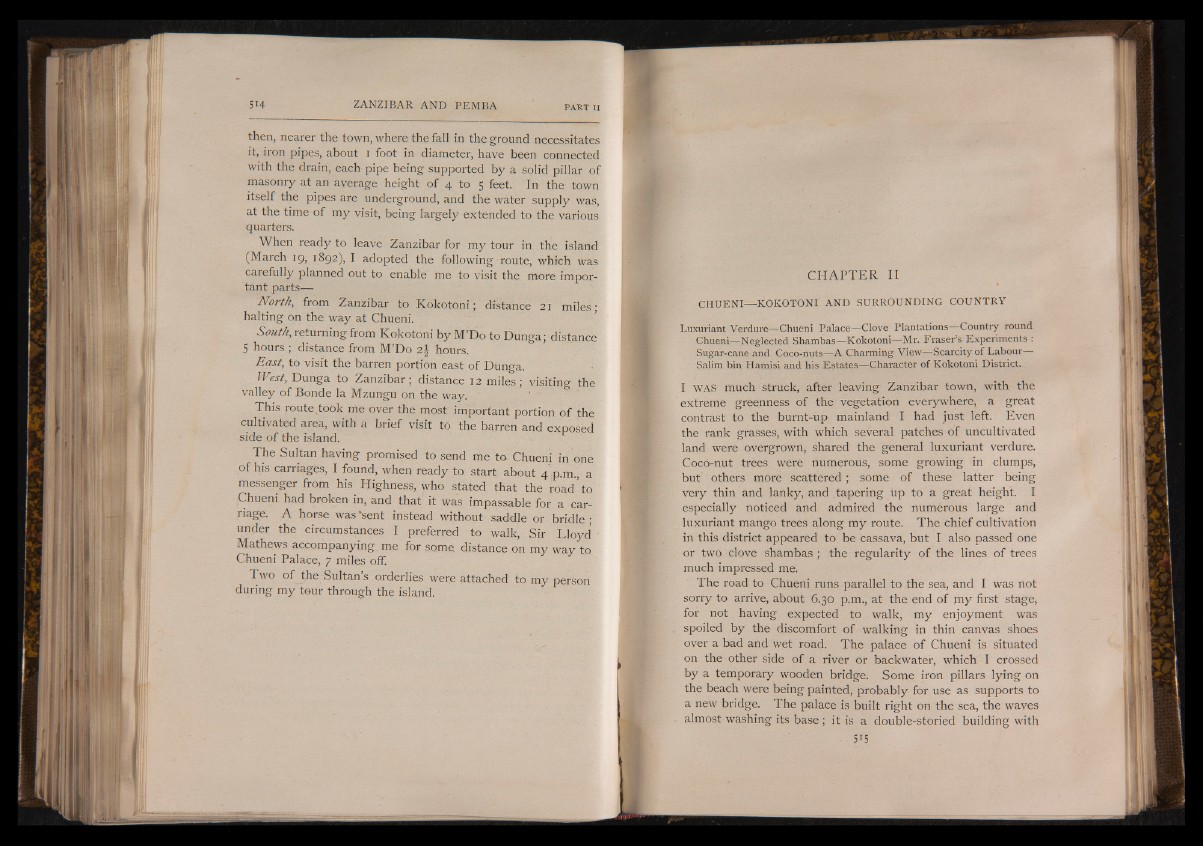
then, nearer the town, where the fall in the ground necessitates
it, iron pipes, about i foot in diameter, have been connected
with the drain, each pipe being supported by a solid pillar of
masonry at an average height of 4 to 5 feet. In the town
itself the pipes are underground, and the water supply was,
at the time of my visit, being largely extended to the various
quarters.
When ready to leave Zanzibar for my tour in the island
(March 19, 1892), I adopted the following route, which was
carefully planned out to enable me to visit the more important
parts—
North, from Zanzibar to Kokotoni ; distance 21 miles;
halting on the way at Chueni.
South, returning from Kokotoni by M’Do to Dunga; distance
S hours ; distance from M’Do 2\ hours.
East, to visit the barren portion east of Dunga.
West, Dunga to Zanzibar; distance 12 miles; visiting the
valley of Bonde la Mzungu on the way.
This route,took me over the most important portion of the
cultivated area, with a brief visit to the barren and exposed
side of the island.
The Sultan having promised to send me to Chueni in one
of his carriages, I found, when ready to start about 4 p.m., a
messenger from his Highness, who stated that the road’ to
Chueni had broken in, and that it was impassable for a carriage.
A horse was‘sent instead without saddle or bridle ;
under the circumstances I preferred to walk, Sir Lloyd
Mathews accompanying me for some, distance on my way to
Chueni Palace, 7 miles off.
Two of the-Sultan’s orderlies were attached to my person
during my tour through the island.
CH A P T ER II
CHUENI— KOKOTONI AND SURROUNDING COUNTRY
Luxuriant Verdure— Chueni Palace—^Clove Plantations— Country round
Chueni— Neglected Shambas— Kokotoni— Mr. Fraser’s Experiments :
Sugar-cane and Coco-nuts—A Charming View— Scarcity of Labour—
Salim bin Hamisi and his Estates— Character of Kokotoni District.
I WAS much struck, after leaving Zanzibar town, with the
extreme greenness of the vegetation everywhere, a great
contrast to the burnt-up mainland I had just left. Even
the rank grasses, with which several patches of uncultivated
land were overgrown, shared the general luxuriant verdure.
Coco-nut trees were numerous, some growing in clumps,
but others more scattered; some of these latter being
very thin and lanky, and tapering up to a great height. I
especially noticed and admired the numerous large and
luxuriant mango trees along my route. The chief cultivation
in this district appeared to be cassava, but I also passed one
or two clove shambas; the regularity of the lines of trees
much impressed me.
The road to Chueni runs parallel to the sea, and I was not
sorry to arrive, about 6.30 p.m., at the end of my first stage,
for not having expected to walk, my enjoyment was
spoiled by the discomfort of walking in thin canvas shoes
over a bad and wet road. The palace of Chueni is situated
on the other side of a river or backwater, which I crossed
by a temporary wooden bridge. Some iron pillars lying on
the beach were being painted, probably for use as supports to
a new bridge. The palace is built right on the sea, the waves
almost washing its base; it is a double-storied building with